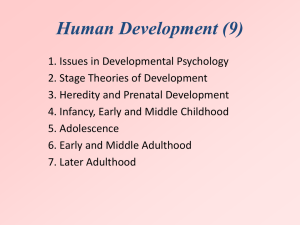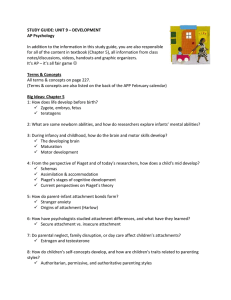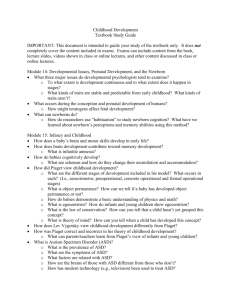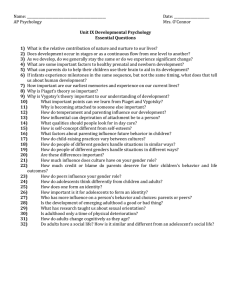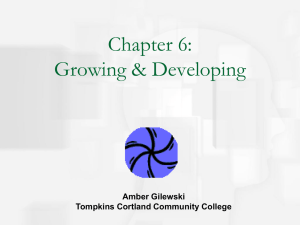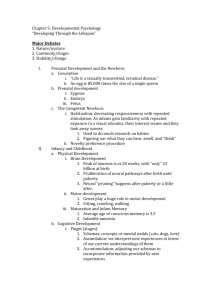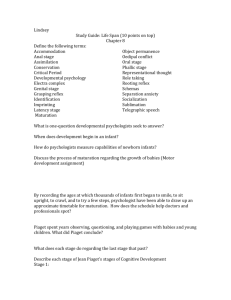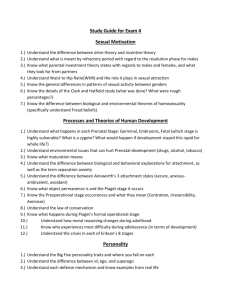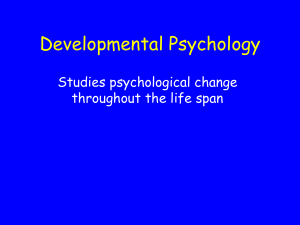Unit 9 packet
advertisement
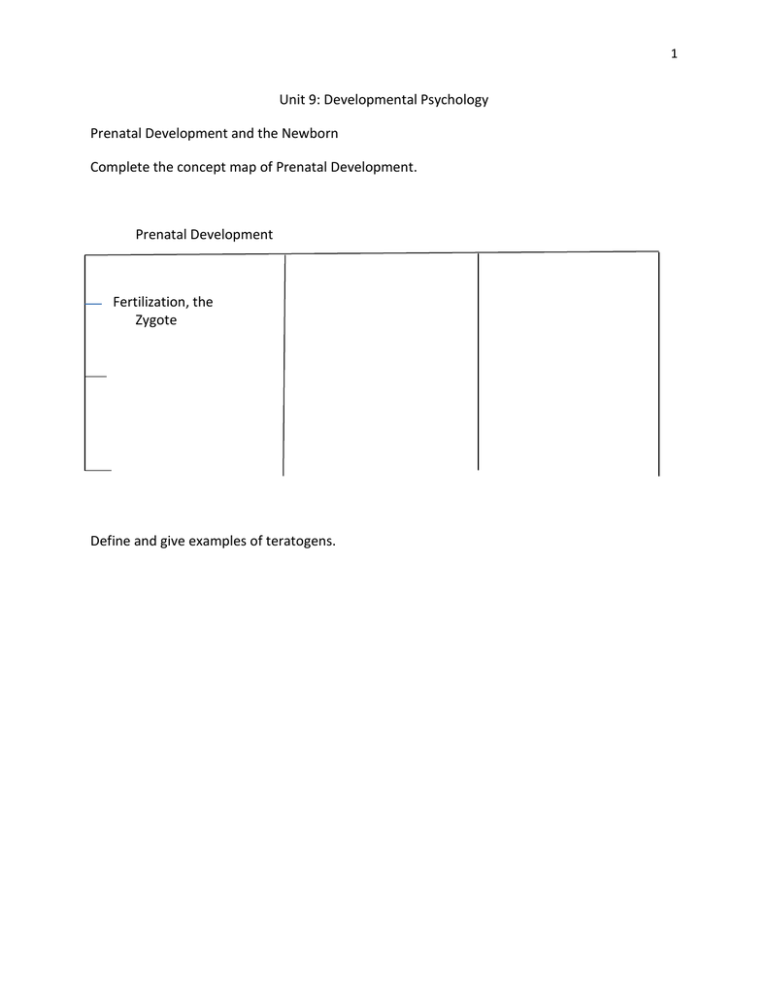
1 Unit 9: Developmental Psychology Prenatal Development and the Newborn Complete the concept map of Prenatal Development. Prenatal Development Fertilization, the Zygote Define and give examples of teratogens. 2 List and describe the newborn’s reflexes. Reflex Description Identify the prenatal stage of development: zygote (Z), embryo (E), or fetus (F) represented by the characteristics below. _____ 1. Two days after conception, cell division begins to occur. _____ 2. Entering the fourth month after conception, it weighs approximately 3 ounces. _____ 3. Cells begin to differentiate and specialize structure and function. _____ 4. At 40 days, the spine is visible and arms and legs begin to grow. _____ 5. In the third month, facial features, hands and feet have formed. 3 Infancy and Childhood Summarize the growth of neurons in the brain from the fetal stage to puberty. Based on information in this section, how might you reply to a friend who insists he remembers events clearly from his first and second years of life. Define and explain the mechanism of maturation. Explain how a child might assimilate and accommodate a schema for a car when presented with a truck. 4 Complete the chart below detailing Piaget’s stages of cognitive development. Stage Approximate Age Range Name and Description of Tasks to Be Mastered Key Words Sensorimotor Preoperational Concrete Operational Formal Operational Discuss the ways in which Lev Vygotsky’s views on the cognitive development of children differ from Jean Piaget’s. 5 List the stage of cognitive development according to Jean Piaget. When noted, also identify the concept described. Sensorimotor (S), preoperational (P), concrete operational (C), formal operational (F) _____ 1. Seven year-old Amal understands that when a cookie is broken into three smaller portions, it is still only one cookie, not three cookies. Concept described: _____________________ _____ 2. Thirteen-year-old Julie is contemplating the different ways humans express love and wondering if feeling love is innate. Concept described: _____________________ _____ 3. One-month-old Na He puts everything she can find into her mouth…her toes, the string on her clothing, even the stuffed elephant her grandmother gave her. _____ 4. Three-year-old Matthew is talking with his aunt on the telephone and when she asks if he enjoyed preschool today, he excitedly nods his head up and down. Concept described: _____________________ _____ 5. Five-month-old Emma cries when you hide her paly toy under the blanket in front of you, but smile delightedly when you pill it back out again. Concept described: ______________ 6 Autism Spectrum Disorder (ASD) What is one explanation for the increase in autism spectrum disorder (ASD) diagnoses and the decrease in the number of children considered learning disabled. List the characteristics associated with ASD. How does ASD impact boys differently from girls. Explain some of the evidence supporting biology’s influence on ASD. What are some of the myths or misconceptions that surround the disorder? 7 Infancy and Childhood: Social Development In what way did Margaret Harlow and Harry Harlow’s experiments with wire and cloth monkeys overturn the previously held belief that attachment was based on satisfaction of nourishment needs? What were the implications of Harlow’s findings? How did the work of Konrad Lorenz add to the explanation of how attachment bonds are formed in children? Use key terms in your response. How did May’s Ainsworth’s work with strange situation design help answer the question of attachment differences? Explain the ways in which early attachment styles predict later personality traits. Explain the cognitive and physical effects of attachment deprivation as illustrated by Romanian children housed in orphanages. List specific outcomes correlated with being raised in abusive homes. 8 How do the terms attachment, self-concept, self-image, and self-esteem differ from one another? Complete the chart for parenting styles. Parenting Style Description Correlation between style and future personality traits Give two examples of how child-raising practices reflect cultural values. 9 Gender Development What statistics does the author include to support his contention that men are more aggressive than women? From your experience, do you agree or disagree with these statistics? What examples does the author cite to support his statement that social power is inequitably distributed? Why might these differences persist in our modern world? What research does the author include that support his view that women are more socially connected than are men? Based on your experience, do you agree or disagree with this view? Discuss how women’s gender roles vary among cultures. Discuss how men’s gender roles vary among cultures. How do gender roles, gender typing, and gender schema, and gender identity relate and differ from one another? How is gender identity different from sexual orientation? 10 Parents and Peers Using information from the book as evidence, support the claim that early experience affects brain development. Using information from the book as evidence, compare and contrast the influence of peers versus parents on development. 11 Adolescence List the benefits and drawbacks to early physical maturation for boys. List the benefits and drawbacks to early physical maturation for girls. Discuss the current trend and implications of research into the undeveloped prefrontal cortex of adolescents. Complete the chart for Kohlberg’s Three Levels of Morality Levels of Morality How Rules are Understood Example 12 Describe the decision an individual might make when considering whether or not to cheat on an exam if they are in the a. preconventional stage: b. conventional stage: c. postconvential stage: How does moral intuition differ from moral action? 13 Complete the chart below by filling in the issue for each stage and the outcomes for Erikson’s Psychosocial Stages of Development. Stage Issue Infancy (to 1 year) Trust v. Mistrust Infant learns a basic sense of trust dependent upon how their needs are meet. Toddler 1 to 3 years of old Preschool Age 3 to 5 year old Elementary School Age 5 to 12 years old Successful Dealing with Crisis If babies’ needs for food, comfort and affection are met, they develop a sense of trust in people and expect those needs to be met in the future. Unsuccessful Dealing with Crisis If babies’ needs for food, comfort and affection are not met, they develop a sense of mistrust and do not expect their needs to be met in the future. 14 Adolescence 13 to early 20s Early Adulthood 20s and 30s Middle Adulthood 40s and 50s Late Adulthood 60s and beyond List the ways research has shown peers influence your personal development. List the ways research has shown parents influence your personal development. 15 Adulthood Complete the following chart for physical changes that occur in men and in women. Physical changes Middle adulthood Later life Interpret the information in Figure 9.34 as it relates to differing abilities of recall and recognition in older adults. (pg. 461) Define the social clock and explain how the “ticking” changes during adulthood. List three findings from studies on grief and coping: 16 Danielle is an 11-year old 5th grader who is the youngest of four children and comes from a stable and loving two-parent home. She lives in suburban Georgia and walks to school each day. She enjoys the piano and has been taking lessons for five years. Stephen is an 11 year old boy abandoned by his parents as a child and raised in a foster home system, bouncing form family to family for the past four years. He currently lives with a couple fostering two other children. He listens to alternative music on his headphones each day as he rides the public bus to the school he attends in the economically depressed town in Smallville. Compare and contrast these two children in terms of the impact of the following: Erikson’s theories of psychosocial development Maturation Influence of peers versus parents Gender roles of their culture Physiological changes of puberty Ainsworth’s theories of attachment
